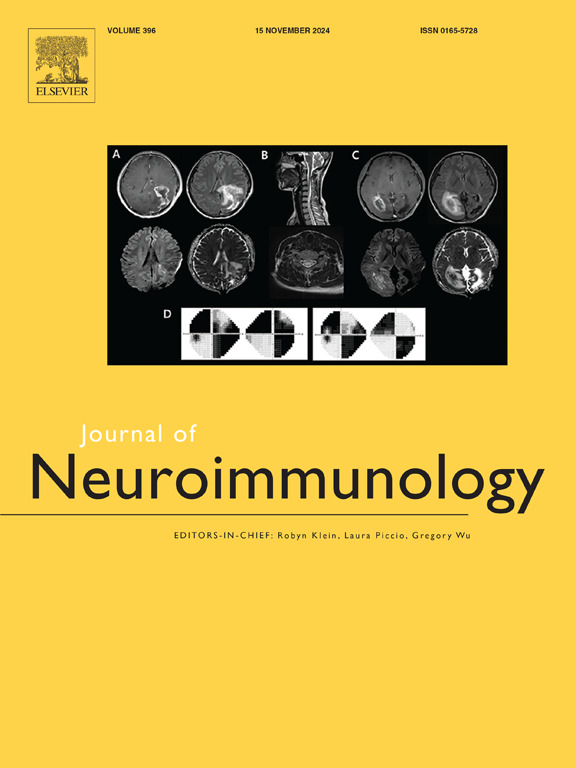在复发-缓解型多发性硬化症患者中,脑网络改变与“无疾病活动证据”状态相关
IF 2.9
4区 医学
Q3 IMMUNOLOGY
引用次数: 0
摘要
在接受口腔疾病改善治疗(DMTs)的复发-缓解型多发性硬化症(RRMS)患者中,结构和功能连接网络(SCN, FCN)的每月拓扑性质变化率(mrTPC)与实现无疾病活动证据(NEDA)之间的关系仍未充分探讨。方法本研究是一项回顾性研究,研究对象为2019年1月至2023年6月期间接受口服dmt治疗或未接受治疗的RRMS患者。所有参与者都进行了基线和随访临床评估以及MRI扫描。最初,评估了所有参与者的NEDA状况。然后,计算SCN和FCN的mrTPCs。最后,将基线特征和mrTPCs插入到逻辑回归模型中,以探索它们与实现NEDA状态的关系。结果共纳入58例RRMS患者,其中治疗组46例,未治疗组12例。接受治疗的RRMS患者达到NEDA3+ (60.87% vs. 25.00%)或NEDA4+ (21.74% vs. 8.33%)状态的比例更高。口腔dmt (P = 0.032)和对比增强病变(CELs)计数较低(P = 0.009)的患者更有可能达到NEDA3+状态。基于mrTPCs的nomogram显示SCN_NLe_SMA。R (P = 0.042)和FCN_NLe_PCL。NEDA3或neda4模型的L (P = 0.050)均有显著性差异。上述两种模型均表现良好(AUC分别为0.756和0.722)。结论mrTPC特异性改变与口服dmt的RRMS患者的NEDA状态有关。尽管每种NEDA状态的具体机制可能不同,需要进一步研究,但这些发现可以帮助临床医生个性化RRMS治疗和监测。本文章由计算机程序翻译,如有差异,请以英文原文为准。
Brain network alteration was associated with ‘no evidence of disease activity’ status in patients with relapsing-remitting multiple sclerosis
Background
The associations between the monthly rate of topological property change (mrTPC) in the structural and functional connectivity network (SCN, FCN) and achieving no evidence of disease activity (NEDA) in relapsing-remitting multiple sclerosis (RRMS) patients taking oral disease-modifying therapies (DMTs) remain insufficiently explored.
Methods
This was a retrospective study conducted with RRMS patients treated with oral DMTs or untreated between January 2019 and June 2023. All participants underwent baseline and follow-up clinical evaluations and MRI scans. Initially, NEDA statuses of all participants were assessed. Then, the mrTPCs from SCN and FCN were calculated. Finally, the baseline characteristics and mrTPCs were inserted into logistic regression models to explore their associations with achieving NEDA status.
Results
A total of 58 RRMS patients were included, with 46 in the treated group and 12 in the untreated group. A greater percentage of treated RRMS patients achieved NEDA3+ (60.87 % vs. 25.00 %) or NEDA4+ (21.74 % vs. 8.33 %) statuses. Patients with oral DMTs (P = 0.032) and lower contrast-enhancing lesions (CELs) count (P = 0.009) were more likely to achieve NEDA3+ status. Nomograms based on the mrTPCs revealed SCN_NLe_SMA.R (P = 0.042) and FCN_NLe_PCL.L (P = 0.050) were significant for the NEDA3 or NEDA 4 model. Both the above models performed well (AUC: 0.756 and 0.722, respectively).
Conclusions
Specifically altered mrTPC was linked to NEDA status in RRMS patients on oral DMTs. Although the specific mechanisms for each NEDA status may differ and need further investigation, these findings can help clinicians personalize RRMS treatment and monitoring.
求助全文
通过发布文献求助,成功后即可免费获取论文全文。
去求助
来源期刊

Journal of neuroimmunology
医学-免疫学
CiteScore
6.10
自引率
3.00%
发文量
154
审稿时长
37 days
期刊介绍:
The Journal of Neuroimmunology affords a forum for the publication of works applying immunologic methodology to the furtherance of the neurological sciences. Studies on all branches of the neurosciences, particularly fundamental and applied neurobiology, neurology, neuropathology, neurochemistry, neurovirology, neuroendocrinology, neuromuscular research, neuropharmacology and psychology, which involve either immunologic methodology (e.g. immunocytochemistry) or fundamental immunology (e.g. antibody and lymphocyte assays), are considered for publication.
 求助内容:
求助内容: 应助结果提醒方式:
应助结果提醒方式:


